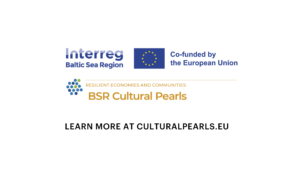How to develop social resilience via creative-cross innovations? Introducing NDPC’s webinar with Abbas Sbeity

Today, the term “resilience” is used extensively in a variety of business, social, and political contexts as well as in the environmental, human, and social sciences. Resilience is more crucial than ever in an era of emerging global threats including pandemics, financial crises, and escalating geopolitical conflicts.
NDPC has been working with the concept of social resilience through the project BSR Cultural Pearls. This is an initiative designed to enhance social resilience in smaller towns, cities, and municipalities within the Baltic Sea Region through cultural engagement; this project supports awarded communities in utilizing culture to foster stronger, more resilient societies by involving citizens, improving quality of life, and nurturing a sense of belonging and trust.
In the context of capacity-building for BSR Cultural Pearls, NDPC hosted a webinar featuring the expert Abbas Sbeity, who is also the author of the Seed Money Initiative, a crucial outcome of the project.
The Seed Money Initiative serves as the BSR Cultural Pearls project’s method to support the awarded BSR Cultural Pearls in piloting and testing new creative solution activities with their local Cultural and Creative Sector (CCS) practitioners. It offers financial assistance to encourage the Pearls to engage with their local CCS in innovative ways and to utilize creative services effectively to foster social resilience. The 3.5M euro project is running for a period of three years until December 2025 and is funded by the Interreg Baltic Sea Region programme.
Explore the resource here
From this article, you will learn:
- What are the key differences between transactional and collaborative relationships in cross-sector partnerships?
- How can public, private, and civil society sectors effectively collaborate to address complex social and urban challenges?
- What role do power dynamics and decision-making processes play in the success of cross-innovation projects?
- How can top-down and bottom-up approaches be integrated to create a hybrid model for more effective collaboration?
- What are the benefits of involving the cultural and creative sectors in projects traditionally managed by the public sector, such as urban safety and placemaking?
Abbas Sbeity is a professional from Creative Insights Studio, a research, strategy, and facilitation studio based in Sweden. When approaching the concept of cross-innovation and collaboration, he draws on his extensive experience in this field, which has largely focused on social, humanitarian, and urban challenges. This work often involved collaboration with the public sector and non-governmental organizations, including large humanitarian and development bodies worldwide.
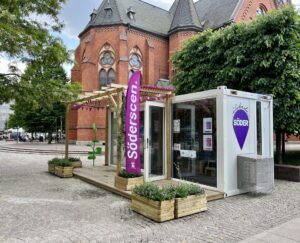
Credits: Abbas Sbeity
A new model of cross-collaboration
He highlights a shift from transactional interactions in the creative and cultural sector—where services are exchanged for resources—to a model of cross-collaboration.
In Abbas’ words: “As a representative of the creative and cultural sector, I have engaged extensively with these organizations. Often, the interaction is transactional—such as purchasing services or providing grants to cultural actors—focused on delivering what is promised in exchange for financial or other resources. However, today, I want to talk about a different model: cross-collaboration, which emphasizes long-term, cooperative relationships.”
In this model, relationships often involve shared decision-making and project ownership, with outcomes that benefit all parties involved. At the core of this approach is the idea of tackling significant societal issues that require a systematic, collaborative effort.
It’s important to understand that these sectors do not operate in isolation. They interact with other sectors, such as the private sector, and ultimately serve the communities who use the services, products, and programs developed through these collaborations.
So, what sets this approach apart? Unlike transactional relationships, which are often short-term, cross-sector collaboration fosters a shared decision-making process. It brings together different partners to co-create projects, sharing ownership and ensuring that outcomes are beneficial for everyone involved.
Abbas gives a practical example talking about his experience working in the Swedish context: “Particularly here in Sweden, I have observed both top-down and bottom-up approaches to collaboration. Top-down initiatives are often led by authorities and take a centralized approach, seeking local engagement; in contrast, bottom-up approaches originate at the grassroots level, where local decisions influence higher-level outcomes. A project I worked on in Helsingborg, Sweden, called Söderscen, illustrates well this concept, with the collaboration between public, private, and cultural actors.”
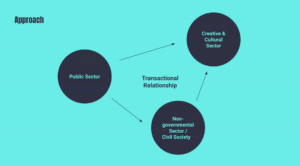
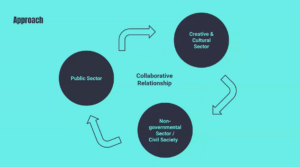
Credits: Abbas Sbeity
Söderscen and the benefits of a hybrid approach
Let’s now introduce Söderscen!
Initiated by the municipality’s city planning department, the project addresses safety and security issues in public spaces, particularly in a district historically developed to house the working class, and later became home to many immigrants. Unfortunately, this area has also been labeled as vulnerable, with a higher risk of criminal activity. The aim is to use placemaking—a strategy that involves collaborative engagement with various stakeholders—to improve public spaces like parks and squares, fostering a sense of community and safety.
For instance, one initiative within this project, the Söderrummet (or South Room), serves as a pop-up space for events, activities, and direct dialogue between residents and municipal departments. Instead of merely installing a structure, the idea was to build it collaboratively with the local community, including children and families. This process has led to a greater sense of ownership and a more vibrant community space. Over the past year and a half, this pop-up has hosted numerous activities, fostering stronger connections between residents and the city.
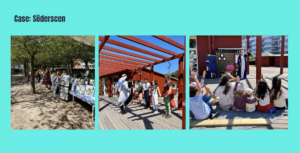
Credits: Abbas Sbeity
Achieving more impactful outcomes: the top-down meets the bottom-up
The benefits of this hybrid approach, which blends top-down and bottom-up elements, are clear. It encourages co-creation, engages local communities, and ensures better coordination among departments that might otherwise work independently. This collaboration allows for experimentation and creative problem-solving, which is often constrained by the rigid, bureaucratic processes of municipal bodies. By working with creative and cultural sector partners, we can introduce more flexibility and opportunities for innovation.
In this process, it’s crucial to manage and understand power dynamics between stakeholders. Rather than seeing power imbalances as obstacles, we should learn to navigate them, moving from a comfort zone to a learning zone. This means enhancing collaborative capabilities, whether as a public sector employee or a creative professional, to tackle projects effectively across diverse contexts.
Overall, there is a significant opportunity for mutual learning and growth in cross-sector collaborations. By understanding the relationships between stakeholders, addressing power dynamics, and adopting a more open, hybrid approach, we can enhance our collaborative efforts and achieve more impactful outcomes.
If you would like to watch the full video, head over to NDPC LinkedIn profile: link
If you are looking for further discussion and food for thought, we have also published an extensive resource on how to approach creative cross-innovations.

